tyre pressure FIAT SEICENTO 2007 1.G Owners Manual
[x] Cancel search | Manufacturer: FIAT, Model Year: 2007, Model line: SEICENTO, Model: FIAT SEICENTO 2007 1.GPages: 154, PDF Size: 3.68 MB
Page 74 of 154
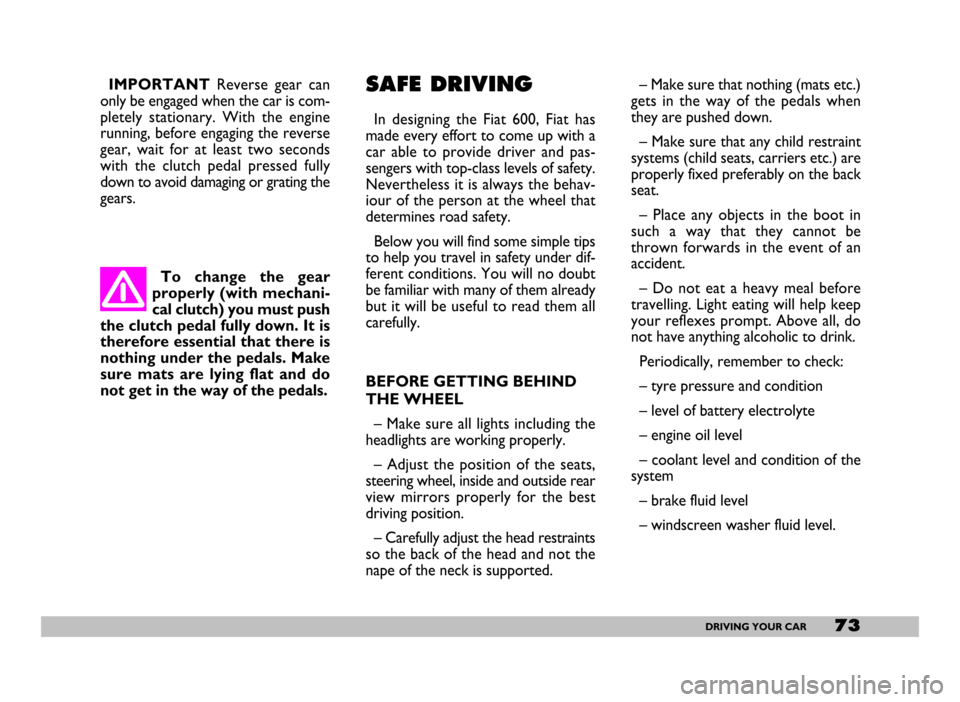
73DRIVING YOUR CAR
IMPORTANT Reverse gear can
only be engaged when the car is com-
pletely stationary. With the engine
running, before engaging the reverse
gear, wait for at least two seconds
with the clutch pedal pressed fully
down to avoid damaging or grating the
gears. SAFE DRIVING
In designing the Fiat 600, Fiat has
made every effort to come up with a
car able to provide driver and pas-
sengers with top-class levels of safety.
Nevertheless it is always the behav-
iour of the person at the wheel that
determines road safety.
Below you will find some simple tips
to help you travel in safety under dif-
ferent conditions. You will no doubt
be familiar with many of them already
but it will be useful to read them all
carefully.
BEFORE GETTING BEHIND
THE WHEEL
– Make sure all lights including the
headlights are working properly.
– Adjust the position of the seats,
steering wheel, inside and outside rear
view mirrors properly for the best
driving position.
– Carefully adjust the head restraints
so the back of the head and not the
nape of the neck is supported. – Make sure that nothing (mats etc.)
gets in the way of the pedals when
they are pushed down.
– Make sure that any child restraint
systems (child seats, carriers etc.) are
properly fixed preferably on the back
seat.
– Place any objects in the boot in
such a way that they cannot be
thrown forwards in the event of an
accident.
– Do not eat a heavy meal before
travelling. Light eating will help keep
your reflexes prompt. Above all, do
not have anything alcoholic to drink.
Periodically, remember to check:
– tyre pressure and condition
– level of battery electrolyte
– engine oil level
– coolant level and condition of the
system
– brake fluid level
– windscreen washer fluid level. To change the gear
properly (with mechani-
cal clutch) you must push
the clutch pedal fully down. It is
therefore essential that there is
nothing under the pedals. Make
sure mats are lying flat and do
not get in the way of the pedals.
Page 77 of 154
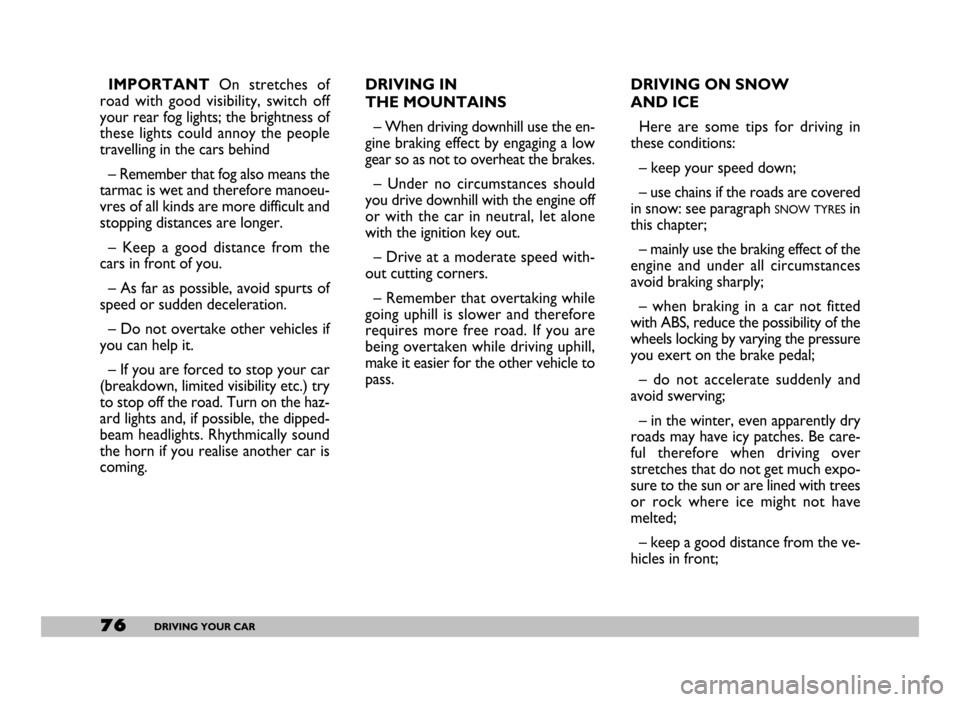
76DRIVING YOUR CAR
IMPORTANT On stretches of
road with good visibility, switch off
your rear fog lights; the brightness of
these lights could annoy the people
travelling in the cars behind
– Remember that fog also means the
tarmac is wet and therefore manoeu-
vres of all kinds are more difficult and
stopping distances are longer.
– Keep a good distance from the
cars in front of you.
– As far as possible, avoid spurts of
speed or sudden deceleration.
– Do not overtake other vehicles if
you can help it.
– If you are forced to stop your car
(breakdown, limited visibility etc.) try
to stop off the road. Turn on the haz-
ard lights and, if possible, the dipped-
beam headlights. Rhythmically sound
the horn if you realise another car is
coming.DRIVING IN
THE MOUNTAINS
– When driving downhill use the en-
gine braking effect by engaging a low
gear so as not to overheat the brakes.
– Under no circumstances should
you drive downhill with the engine off
or with the car in neutral, let alone
with the ignition key out.
– Drive at a moderate speed with-
out cutting corners.
– Remember that overtaking while
going uphill is slower and therefore
requires more free road. If you are
being overtaken while driving uphill,
make it easier for the other vehicle to
pass. DRIVING ON SNOW
AND ICE
Here are some tips for driving in
these conditions:
– keep your speed down;
– use chains if the roads are covered
in snow: see paragraph
SNOW TYRESin
this chapter;
– mainly use the braking effect of the
engine and under all circumstances
avoid braking sharply;
– when braking in a car not fitted
with ABS, reduce the possibility of the
wheels locking by varying the pressure
you exert on the brake pedal;
– do not accelerate suddenly and
avoid swerving;
– in the winter, even apparently dry
roads may have icy patches. Be care-
ful therefore when driving over
stretches that do not get much expo-
sure to the sun or are lined with trees
or rock where ice might not have
melted;
– keep a good distance from the ve-
hicles in front;
Page 79 of 154
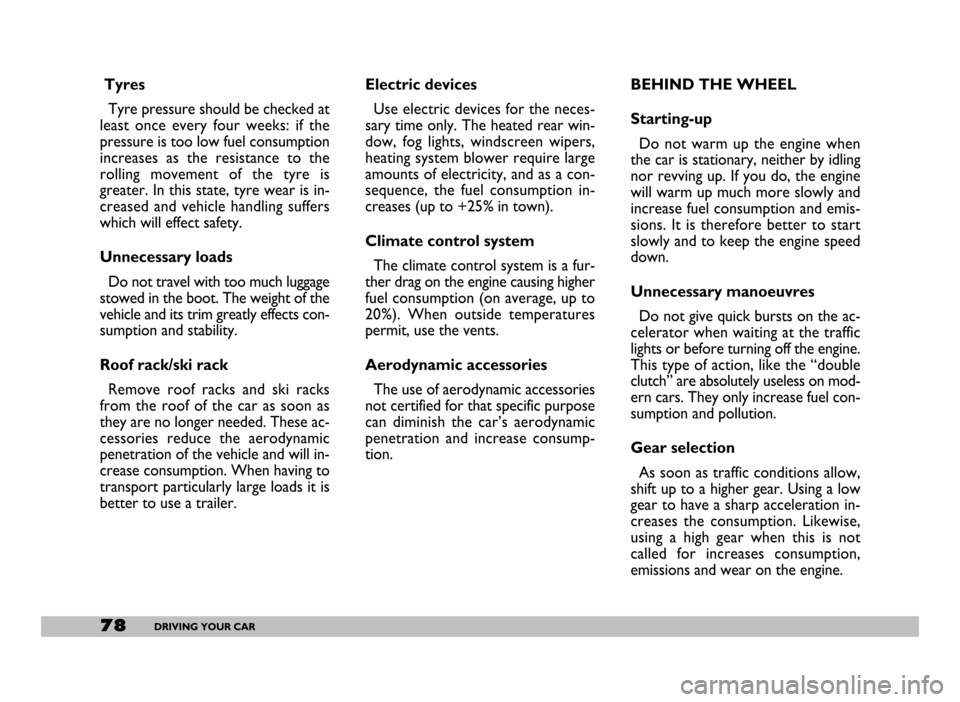
78DRIVING YOUR CAR
Tyres
Tyre pressure should be checked at
least once every four weeks: if the
pressure is too low fuel consumption
increases as the resistance to the
rolling movement of the tyre is
greater. In this state, tyre wear is in-
creased and vehicle handling suffers
which will effect safety.
Unnecessary loads
Do not travel with too much luggage
stowed in the boot. The weight of the
vehicle and its trim greatly effects con-
sumption and stability.
Roof rack/ski rack
Remove roof racks and ski racks
from the roof of the car as soon as
they are no longer needed. These ac-
cessories reduce the aerodynamic
penetration of the vehicle and will in-
crease consumption. When having to
transport particularly large loads it is
better to use a trailer.Electric devices
Use electric devices for the neces-
sary time only. The heated rear win-
dow, fog lights, windscreen wipers,
heating system blower require large
amounts of electricity, and as a con-
sequence, the fuel consumption in-
creases (up to +25% in town).
Climate control system
The climate control system is a fur-
ther drag on the engine causing higher
fuel consumption (on average, up to
20%). When outside temperatures
permit, use the vents.
Aerodynamic accessories
The use of aerodynamic accessories
not certified for that specific purpose
can diminish the car’s aerodynamic
penetration and increase consump-
tion.BEHIND THE WHEEL
Starting-up
Do not warm up the engine when
the car is stationary, neither by idling
nor revving up. If you do, the engine
will warm up much more slowly and
increase fuel consumption and emis-
sions. It is therefore better to start
slowly and to keep the engine speed
down.
Unnecessary manoeuvres
Do not give quick bursts on the ac-
celerator when waiting at the traffic
lights or before turning off the engine.
This type of action, like the “double
clutch” are absolutely useless on mod-
ern cars. They only increase fuel con-
sumption and pollution.
Gear selection
As soon as traffic conditions allow,
shift up to a higher gear. Using a low
gear to have a sharp acceleration in-
creases the consumption. Likewise,
using a high gear when this is not
called for increases consumption,
emissions and wear on the engine.
Page 85 of 154

84DRIVING YOUR CAR
WINTER TYRES
These are tyres which have been
specifically designed for use on snow
and ice and should be fitted in place of
the existing tyres.
Use winter tyres of the same size as
the tyres provided with the car.
Fiat Dealerships will be glad to of-
fer advice on the right type of tyres
according to your needs.
For information on the tyres to be
fitted, inflation pressure and winter
tyre specifications, follow the pre-
scriptions given in
WHEELS, TECHNICAL
SPECIFICATIONS
.The performance of winter tyres is
greatly reduced when the depth of the
tread is less than 4 mm. In this situa-
tion it would be safer to have them
replaced.
The specific characteristics of the
winter tyres mean that under normal
driving conditions or when driving
long distances on motorways, their
performance is greatly reduced in
comparison to those normally fitted
to the car.
The use of these tyres should there-
fore be limited to the conditions for
which they were designed.
IMPORTANTWhen using winter
tyres with a maximum speed rating
lower than the speed which can be
reached by the car (plus 5%), place a
suitable notice is the passenger com-
partment to inform the driver of the
top speed which the winter tyre can
run at (as per EC Directive).All four tyres should be the same
(brand and track) to ensure greater
safety when driving, braking and cor-
nering.
Remember not to invert the tyre di-
rection of rotation.
The maximum speed
for winter tyres with “Q”
marking is 160 km/h. Re-
spect the highway code speed
limits.
Page 87 of 154
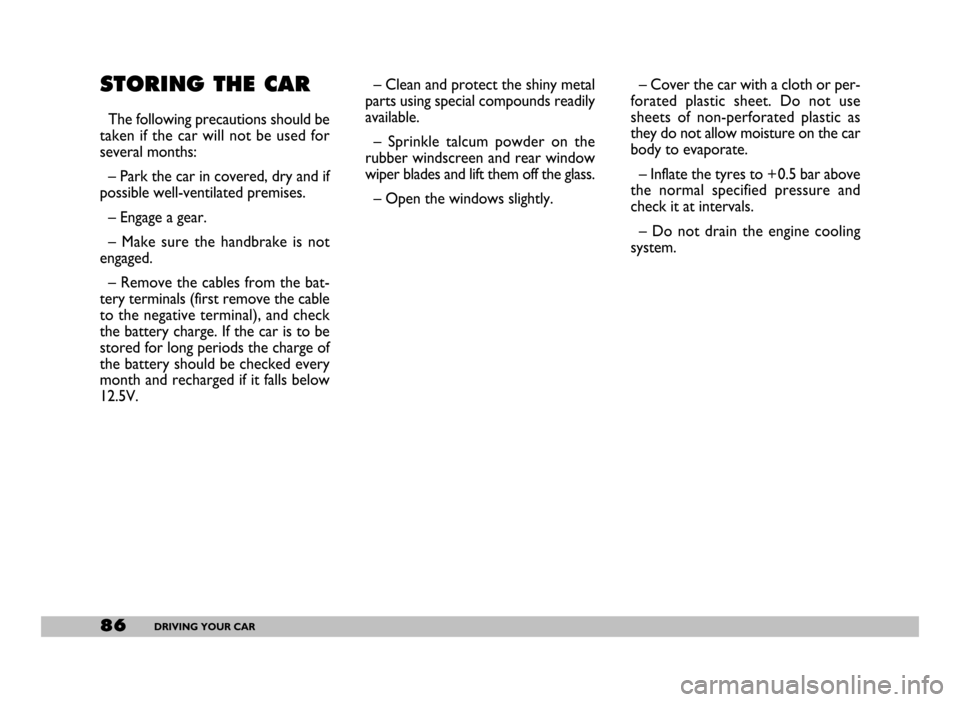
86DRIVING YOUR CAR
STORING THE CAR
The following precautions should be
taken if the car will not be used for
several months:
– Park the car in covered, dry and if
possible well-ventilated premises.
– Engage a gear.
– Make sure the handbrake is not
engaged.
– Remove the cables from the bat-
tery terminals (first remove the cable
to the negative terminal), and check
the battery charge. If the car is to be
stored for long periods the charge of
the battery should be checked every
month and recharged if it falls below
12.5V.– Clean and protect the shiny metal
parts using special compounds readily
available.
– Sprinkle talcum powder on the
rubber windscreen and rear window
wiper blades and lift them off the glass.
– Open the windows slightly.– Cover the car with a cloth or per-
forated plastic sheet. Do not use
sheets of non-perforated plastic as
they do not allow moisture on the car
body to evaporate.
– Inflate the tyres to + 0.5 bar above
the normal specified pressure and
check it at intervals.
– Do not drain the engine cooling
system.
Page 91 of 154
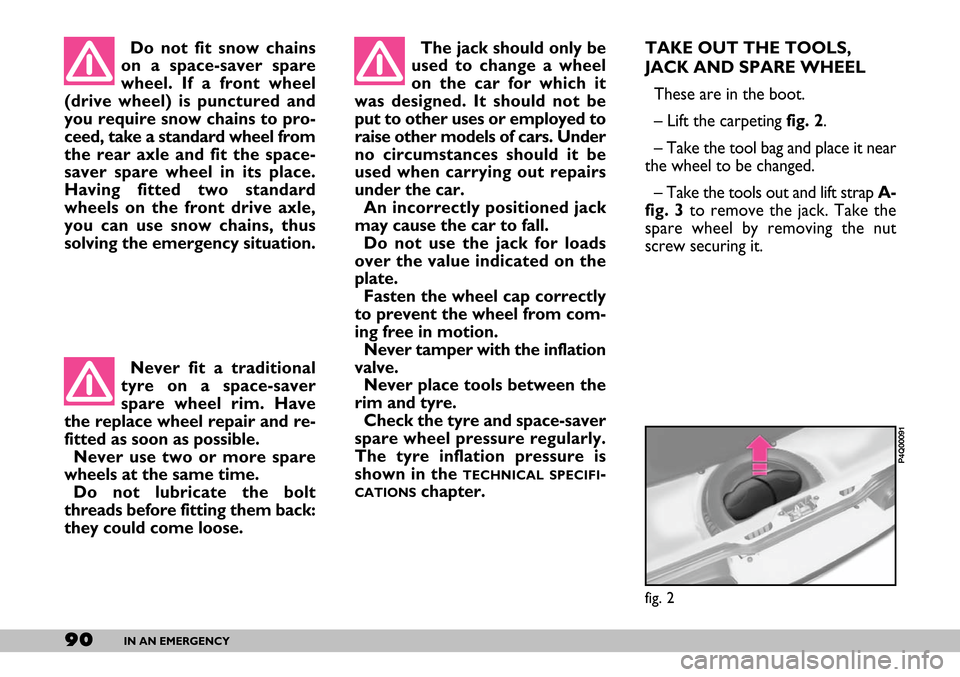
90IN AN EMERGENCY
TAKE OUT THE TOOLS,
JACK AND SPARE WHEEL
These are in the boot.
– Lift the carpeting fig. 2.
– Take the tool bag and place it near
the wheel to be changed.
– Take the tools out and lift strap A-
fig. 3to remove the jack. Take the
spare wheel by removing the nut
screw securing it.
fig. 2
P4Q00091
Do not fit snow chains
on a space-saver spare
wheel. If a front wheel
(drive wheel) is punctured and
you require snow chains to pro-
ceed, take a standard wheel from
the rear axle and fit the space-
saver spare wheel in its place.
Having fitted two standard
wheels on the front drive axle,
you can use snow chains, thus
solving the emergency situation. The jack should only be
used to change a wheel
on the car for which it
was designed. It should not be
put to other uses or employed to
raise other models of cars. Under
no circumstances should it be
used when carrying out repairs
under the car.
An incorrectly positioned jack
may cause the car to fall.
Do not use the jack for loads
over the value indicated on the
plate.
Fasten the wheel cap correctly
to prevent the wheel from com-
ing free in motion.
Never tamper with the inflation
valve.
Never place tools between the
rim and tyre.
Check the tyre and space-saver
spare wheel pressure regularly.
The tyre inflation pressure is
shown in the
TECHNICAL SPECIFI-
CATIONSchapter. Never fit a traditional
tyre on a space-saver
spare wheel rim. Have
the replace wheel repair and re-
fitted as soon as possible.
Never use two or more spare
wheels at the same time.
Do not lubricate the bolt
threads before fitting them back:
they could come loose.
Page 93 of 154
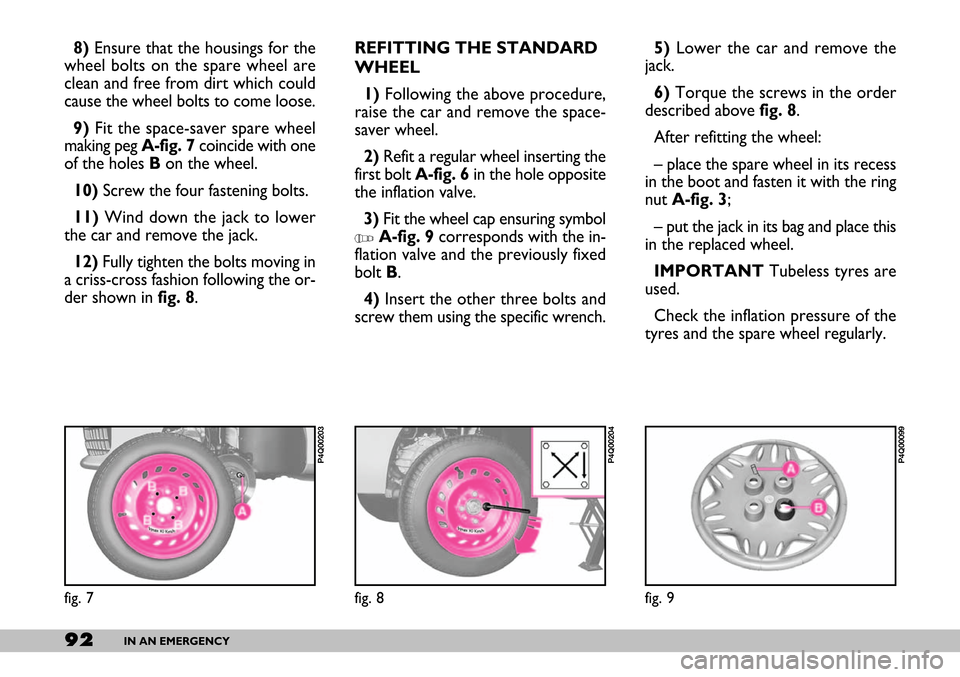
92IN AN EMERGENCY
5) Lower the car and remove the
jack.
6)Torque the screws in the order
described above fig. 8.
After refitting the wheel:
– place the spare wheel in its recess
in the boot and fasten it with the ring
nut A-fig. 3;
– put the jack in its bag and place this
in the replaced wheel.
IMPORTANTTubeless tyres are
used.
Check the inflation pressure of the
tyres and the spare wheel regularly.
fig. 9
P4Q00099
8) Ensure that the housings for the
wheel bolts on the spare wheel are
clean and free from dirt which could
cause the wheel bolts to come loose.
9) Fit the space-saver spare wheel
making peg A-fig. 7coincide with one
of the holes B on the wheel.
10)Screw the four fastening bolts.
11)Wind down the jack to lower
the car and remove the jack.
12)Fully tighten the bolts moving in
a criss-cross fashion following the or-
der shown in fig. 8.REFITTING THE STANDARD
WHEEL
1)Following the above procedure,
raise the car and remove the space-
saver wheel.
2)Refit a regular wheel inserting the
first bolt A-fig. 6in the hole opposite
the inflation valve.
3)Fit the wheel cap ensuring symbol
YA-fig. 9corresponds with the in-
flation valve and the previously fixed
bolt B.
4)Insert the other three bolts and
screw them using the specific wrench.
fig. 7
P4Q00203
fig. 8
P4Q00204
Page 110 of 154
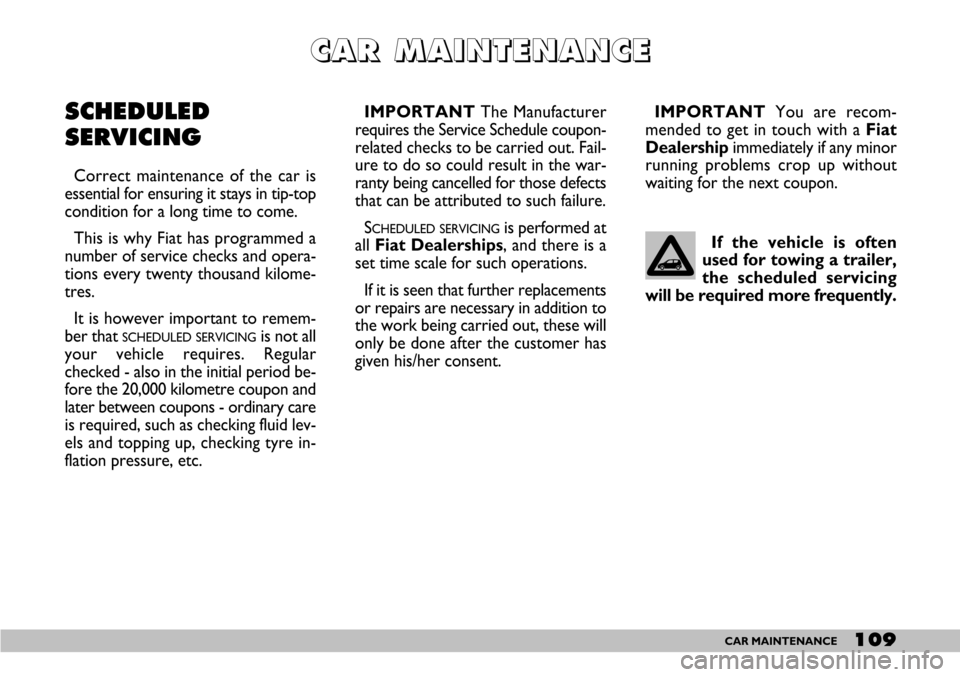
109CAR MAINTENANCE
If the vehicle is often
used for towing a trailer,
the scheduled servicing
will be required more frequently.
C C C C
A A A A
R R R R
M M M M
A A A A
I I I I
N N N N
T T T T
E E E E
N N N N
A A A A
N N N N
C C C C
E E E E
SCHEDULED
SERVICING
Correct maintenance of the car is
essential for ensuring it stays in tip-top
condition for a long time to come.
This is why Fiat has programmed a
number of service checks and opera-
tions every twenty thousand kilome-
tres.
It is however important to remem-
ber that
SCHEDULED SERVICINGis not all
your vehicle requires. Regular
checked - also in the initial period be-
fore the 20,000 kilometre coupon and
later between coupons - ordinary care
is required, such as checking fluid lev-
els and topping up, checking tyre in-
flation pressure, etc. IMPORTANTThe Manufacturer
requires the Service Schedule coupon-
related checks to be carried out. Fail-
ure to do so could result in the war-
ranty being cancelled for those defects
that can be attributed to such failure.
S
CHEDULED SERVICINGis performed at
all Fiat Dealerships, and there is a
set time scale for such operations.
If it is seen that further replacements
or repairs are necessary in addition to
the work being carried out, these will
only be done after the customer has
given his/her consent.IMPORTANT You are recom-
mended to get in touch with a Fiat
Dealershipimmediately if any minor
running problems crop up without
waiting for the next coupon.
Page 111 of 154
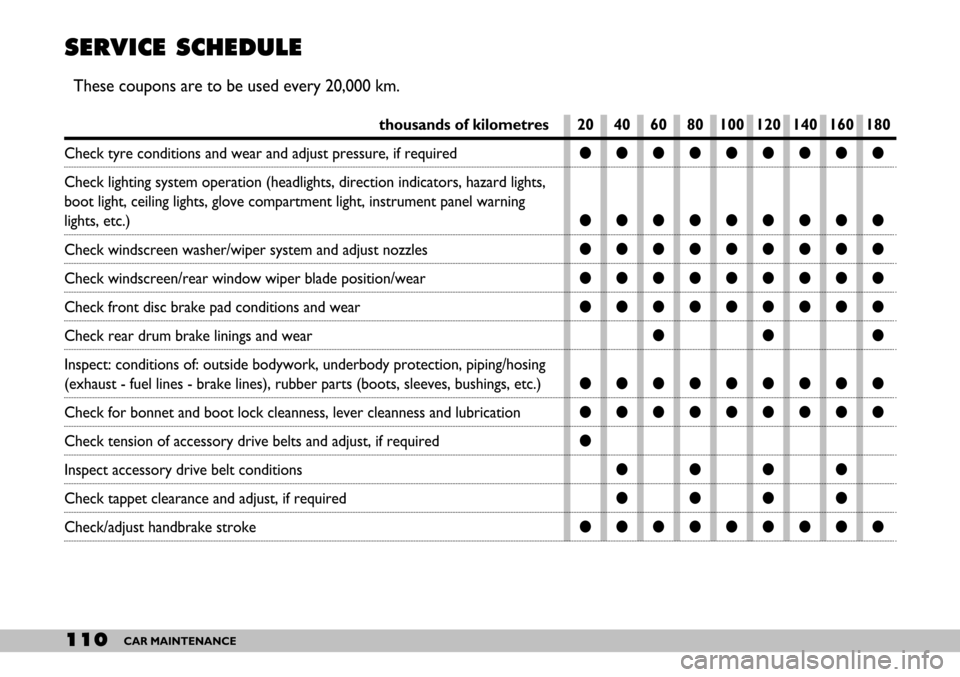
110CAR MAINTENANCE
SERVICE SCHEDULE
These coupons are to be used every 20,000 km.
thousands of kilometres
Check tyre conditions and wear and adjust pressure, if required
Check lighting system operation (headlights, direction indicators, hazard lights,
boot light, ceiling lights, glove compartment light, instrument panel warning
lights, etc.)
Check windscreen washer/wiper system and adjust nozzles
Check windscreen/rear window wiper blade position/wear
Check front disc brake pad conditions and wear
Check rear drum brake linings and wear
Inspect: conditions of: outside bodywork, underbody protection, piping/hosing
(exhaust - fuel lines - brake lines), rubber parts (boots, sleeves, bushings, etc.)
Check for bonnet and boot lock cleanness, lever cleanness and lubrication
Check tension of accessory drive belts and adjust, if required
Inspect accessory drive belt conditions
Check tappet clearance and adjust, if required
Check/adjust handbrake stroke20 40 60 80 100 120 140 160 180
●●●●●●●●●
●●●●●●●●●
●●●●●●●●●
●●●●●●●●●
●●●●●●●●●
●●●
●●●●●●●●●
●●●●●●●●●
●
●●●●
●●●●
●●●●●●●●●
Page 113 of 154
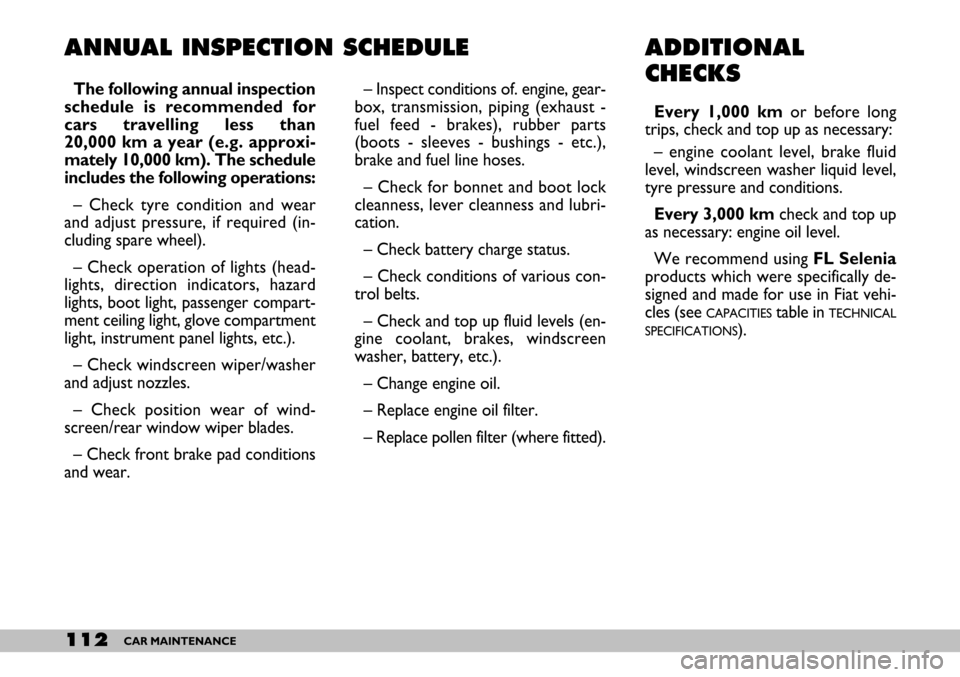
112CAR MAINTENANCE
ANNUAL INSPECTION SCHEDULE
– Inspect conditions of. engine, gear-
box, transmission, piping (exhaust -
fuel feed - brakes), rubber parts
(boots - sleeves - bushings - etc.),
brake and fuel line hoses.
– Check for bonnet and boot lock
cleanness, lever cleanness and lubri-
cation.
– Check battery charge status.
– Check conditions of various con-
trol belts.
– Check and top up fluid levels (en-
gine coolant, brakes, windscreen
washer, battery, etc.).
– Change engine oil.
– Replace engine oil filter.
– Replace pollen filter (where fitted). The following annual inspection
schedule is recommended for
cars travelling less than
20,000 km a year (e.g. approxi-
mately 10,000 km). The schedule
includes the following operations:
– Check tyre condition and wear
and adjust pressure, if required (in-
cluding spare wheel).
– Check operation of lights (head-
lights, direction indicators, hazard
lights, boot light, passenger compart-
ment ceiling light, glove compartment
light, instrument panel lights, etc.).
– Check windscreen wiper/washer
and adjust nozzles.
– Check position wear of wind-
screen/rear window wiper blades.
– Check front brake pad conditions
and wear.
ADDITIONAL
CHECKS
Every 1,000 kmor before long
trips, check and top up as necessary:
– engine coolant level, brake fluid
level, windscreen washer liquid level,
tyre pressure and conditions.
Every 3,000 kmcheck and top up
as necessary: engine oil level.
We recommend using FL Selenia
products which were specifically de-
signed and made for use in Fiat vehi-
cles (see
CAPACITIEStable in TECHNICAL
SPECIFICATIONS
).